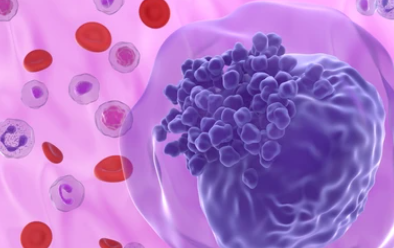Wang Lan’s research group of the Chinese Academy of Sciences Shanghai Institute of Nutrition and Health published the research achievement entitled “The cell non-autonomous function of ID1 promotes AML progression via ANGPTL7 from the microenvironment” online on Blood. This study reveals the key role of transcription regulatory factor ID1 in the bone marrow microenvironment in the initiation and progression of acute myeloid leukemia (AML), providing new ideas and strategies for the treatment of AML.
AML is a malignant disease originating from hematopoietic stem/progenitor cells. Its characteristic is that the ability of myeloid precursor cells to undergo malignant clonal proliferation and differentiate into mature blood cells is hindered. AML is a common adult leukemia, and its high heterogeneity affects the prognosis and outcome of the disease. At present, significant progress has been made in the diagnosis and treatment of AML with the update of drugs and methods, but there is an urgent need to improve the understanding of the pathogenesis of AML and develop new treatment methods.
The occurrence and development of AML are often accompanied by abnormal gene expression. Previous studies have shown that ID1 is a direct target gene for the pathogenic fusion protein AML1-ETO, and is significantly overexpressed in leukemia cells. The direct interaction between ID1 and AKT1 in leukemia cells promotes the phosphorylation of AKT1, thereby accelerating the initiation and progression of AML1-ETO-driven leukemia. ID1 has opposite functions in MLL-AF9-driven leukemia fetal liver transplantation mouse models simulating childhood leukemia and MLL-AF9-driven leukemia bone marrow transplantation mouse models simulating adult leukemia. ID1 promotes the self-renewal of MLL-AF9-driven leukemia stem cells in children and inhibits the occurrence of MLL-AF9-driven leukemia in adults.

Research has found that ID1 is highly expressed in bone marrow mesenchymal stem cells derived from AML patients. This high expression is more significant in leukemia associated with AML1-ETO and MLL-AF9 fusion proteins. In order to investigate the reasons for the increased expression of ID1 in the AML bone marrow microenvironment, the study used ChIP-seq analysis and found that the pathogenic fusion proteins AML1-ETO and MLL-AF9 directly bind to the promoter region of BMP6. Researchers knocked down BMP6 in AML cells and then co-cultured these cells with stromal cells. The results showed that low expression of BMP6 in AML cells significantly reduced the expression of ID1 in co-cultured stromal cells, indicating that AML cells promote the expression of ID1 in stromal cells by secreting BMP6. Through mouse transplantation experiments, it was found that in Id1 deficient receptors, the initiation and progression of AML induced by AML1-ETO9a and MLL-AF9 were significantly delayed, and the self-renewal ability of leukemia stem cells was significantly inhibited. Through in vitro co-culture experiments, it was found that ID1 deficiency in bone marrow stromal cells can significantly inhibit the proliferation of co-cultured AML cells and cause cycle arrest.
Mechanically, quantitative proteomics analysis was used to analyze the bone marrow fluid of AML receptor mice, and it was found that Id1 regulates the expression of secretory glycoprotein Angptl7 in the bone marrow microenvironment, accelerating the occurrence and development of leukemia. Research has shown that ANGPTL7 can promote self-renewal of leukemia stem cells. Researchers added ANGPTL7 recombinant protein to the in vitro co-culture system and found that the inhibition of AML cell proliferation and cycle arrest caused by ID1 deficiency were significantly reversed; By infusing Angptl7 recombinant protein into the bone marrow cavity of AML receptor, it was found that the reduction of AML receptor leukemia stem cells and delayed survival caused by Id1 deficiency were significantly reversed.
In order to further explore how ID1 regulates the expression of ANGPTL7, experiments such as mass spectrometry analysis and immunoprecipitation revealed a direct interaction between the SIM domain of the carboxyl end of ID1 and the amino end of RNF4. RNF4 is the E3 ubiquitin ligase of SP1, and the interaction between ID1 and RNF4 significantly inhibits RNF4’s ubiquitination modification of SP1, thereby maintaining the level of SP1 protein. SP1 is a transcription factor of ANGPTL7, therefore ID1 in the AML bone marrow microenvironment promotes the expression of ANGPTL7 by inhibiting the RNF4-SP1 interaction, thereby affecting the occurrence and development of AML.
This study revealed that ID1 in the bone marrow microenvironment regulates the occurrence and development of leukemia by promoting the expression of ANGPTL7, and revealed that AML cells promote the expression of ID1 in the bone marrow microenvironment by secreting BMP6. This loop of interaction between the bone marrow microenvironment and AML cells may have guiding significance for clinical AML treatment.
Related Products & Service
Protein Expression and Purification Services
Reference
Fei MY, Wang Y, Chang BH, et al. The cell non-autonomous function of ID1 promotes AML progression via ANGPTL7 from the microenvironment. Blood. 2023 Jun 15:blood.2022019537. doi: 10.1182/blood.2022019537. Epub ahead of print. PMID: 37319434.